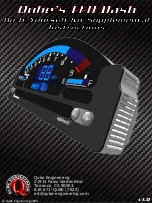
STARTING AND OPERATING
411
Curb Weight
The curb weight of a vehicle is defined as the total weight of
the vehicle with all fluids, including vehicle fuel, at full
capacity conditions, and with no occupants or cargo loaded
into the vehicle. The front and rear curb weight values are
determined by weighing your vehicle on a commercial scale
before any occupants or cargo are added.
Loading
The actual total weight and the weight of the front and rear
of your vehicle at the ground can best be determined by
weighing it when it is loaded and ready for operation.
The entire vehicle should first be weighed on a commercial
scale to insure that the GVWR has not been exceeded. The
weight on the front and rear of the vehicle should then be
determined separately to be sure that the load is properly
distributed over the front and rear axle. Weighing the vehicle
may show that the GAWR of either the front or rear axles has
been exceeded but the total load is within the specified
GVWR. If so, weight must be shifted from front to rear or
rear to front as appropriate until the specified weight limita
-
tions are met. Store the heavier items down low and be sure
that the weight is distributed equally. Stow all loose items
securely before driving.
Improper weight distributions can have an adverse effect on
the way your vehicle steers and handles and the way the
brakes operate.
TRAILER TOWING
In this section you will find safety tips and information on
limits to the type of towing you can reasonably do with your
vehicle. Before towing a trailer, carefully review this infor
-
mation to tow your load as efficiently and safely as possible.
To maintain the New Vehicle Limited Warranty coverage,
follow the requirements and recommendations in this
manual concerning vehicles used for trailer towing.
CAUTION!
Do not load your vehicle any heavier than the GVWR or
the maximum front and rear GAWR. If you do, parts on
your vehicle can break, or it can change the way your
vehicle handles. This could cause you to lose control.
Also overloading can shorten the life of your vehicle.
5
Summary of Contents for 2500 2019
Page 341: ...STARTING AND OPERATING 339 Understanding The Features Of Your Winch Winch Components 5...
Page 367: ...STARTING AND OPERATING 365 Distance Setting 3 Bars Long Distance Setting 2 Bars Medium 5...
Page 383: ...STARTING AND OPERATING 381 Single 1 2 Second Tone Slow Tone 5...
Page 384: ...382 STARTING AND OPERATING Slow Tone Fast Tone...
Page 385: ...STARTING AND OPERATING 383 Fast Tone Continuous Tone 5...
Page 392: ...390 STARTING AND OPERATING Slow Tone For Rear Only Fast Tone For Rear Only...
















































